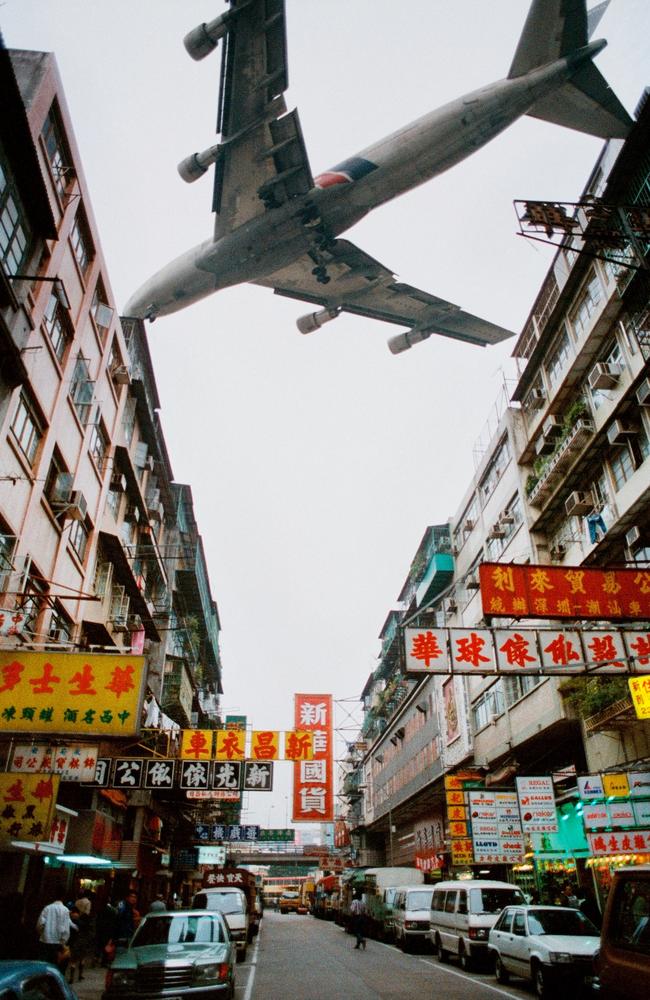Old airport with ‘world’s trickiest landing’
Pilots would have to navigate rugged mountains and high-rise buildings with the notorious runway only visible with a very specific technique.

It was deemed one of the trickiest landing strips in the world with pilots having to navigate through rugged mountains and high-rise buildings as they approached the notorious Runway 13.
Kai Tak Airport in Hong Kong was located on the eastern side of Kowloon Bay where it was surrounded by built up apartments and mountains some 600m high.
It was in operation from 1925 to 1998, but was forced to close as it had begun to outgrow its site with no room for expansion.

As such, it was eventually replaced with what we know now to be Hong Kong International Airport.
When Qantas launched its first route from Sydney to Hong Kong in June 1949, its pilots were among many others who had to take on the infamous Runway 13, which was near a range of mountains.
As it sat in the middle of Kowloon City, with a runway protruding into the sea, landing in Kai Tak was a hair-raising event where passengers were known to hold their breathe they knew the plane was safely on the tarmac.

It was exactly 75 years ago when the national carrier’s Douglas DC-4 Skymaster four-engine propeller aircraft touched down at Kai Tak Airport with the first Sydney to Hong Kong route taking just over 20 hours.
Those first services travelled the 7,650km distance between the two destinations via Darwin and Labuan in East Malaysia.
Pilots, including those navigating the 40 passenger Qantas Skymaster, used their great skill to make a series of complex manoeuvres as they approached Runway 13.

Known as the “chequerboard approach”, pilots would have to make a 47 degree right turn to line up with the runway.
Daryl Chapman, a teacher and aviation photographer from Britain, who has lived in Hong Kong since 1987, witnessed many close calls on Runway 13.
“Kai Tak was very different to most international airports because it was right in the city,” he told CNN last year.

“Lion Rock (a prominent hill in Hong Kong) blocks the standard straight-in approach; thus planes had to make that special turn over Kowloon City while landing on Runway 13.
He said heavy rain would make landing even more challenging with some pilots aborting landing only to go around for another attempt.
Former Cathay Pacific Airways’ general manager of operations, who is now a flying instructor, Russell Davie fondly remembers Kai Tak Airport.

“As a pilot, it was totally unique. It was the only major airport in the world that required a 45 degree turn below 500ft to line up with the runway, literally flying between the high-rise buildings, passing close to the famous orange and white Checkerboard Hill (also known as Kowloon Tsai Hill) as you made that final turn toward the runway,” he explained.
A quick search on YouTube will show several videos of aircraft, including a Qantas 767, flying into the challenging airport.


Captain Jack Ip, director of the Training Centre Aviation Academy, who also grew up in Kai Tak, said it was one of the most difficult approaches in terms of airport arrival.
“We had to execute a manual manoeuvre – turn, descend and line up with the runway. At the end you have to do a 47 degree diversion from the inbound track,” he told the South China Morning Post.

He said the line up, the wind speed and direction, as well as other weather components, made it very challenging.
To execute the manual landing the Checkerboard Hill played a crucial role as pilots looked for it as a visual reference, given it wasn’t obscured by any trees or buildings.
“I understand that some foreign carriers were shown videos or hold very special briefings to the pilots before they boarded the plane inbound for Hong Kong.”

After 73 years of operation, the airport was relocated on the island of Chek Lap Kok in western Hong Kong as it outgrew the site.
It continues to be one of the world’s most busiest airports with Qantas now operating more than 700 passenger flights on its A330-200 to and from Australia; some 200,000 seats per year.

The 20 hour journey also looks very different today with the route taking just over nine hours.
That first service, just four years after World War II ended, was a pivotal moment in history for the national carrier as it would mark a longstanding relationship between the two islands.
“As a 103-year-old airline and Australia’s national carrier, we have a rich history of operations around the globe, but there are few places we’ve consistently served longer than Hong Kong,” Qantas executive vice president Asia, Nick McGlynn said.
“From a long and bumpy journey aboard a low-flying propeller aircraft 75 years ago, to a nine hour hop aboard one of our Airbus A330s today, the story of Qantas in Hong Kong captures the remarkable development of the aviation industry.”

The thriving destination continues to be a critical hub on the Qantas international network, providing trade and tourism connections as well as significant freight uplift.
Southbound services are regularly filled with e-commerce and electronic goods such as smartphones, while northbound flights are heavy with fresh Australian produce such as seafood, dairy, fruit and vegetables – with lots of mangoes and fresh berries.
Also, a number of the A330-200s servicing the route actually share the same Australian aircraft registrations as the original Douglas DC-4 Skymasters that flew to Hong Kong in 1949.
The American aircraft had a maximum range of 4000kms, with a cruising speed of 350kph and flew the Hong Kong route from June 26, 1949 until 1957 when services were increased from fortnightly to weekly, operated by L1049 Super Constellations via Darwin and Manila. Today, all passengers arrive into Hong Kong at Chek Lap Kok – a purpose built, three runway man-made island in western Hong Kong following growing demand.






